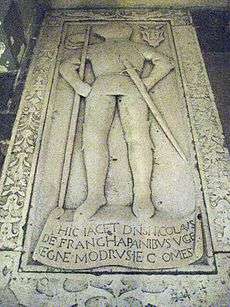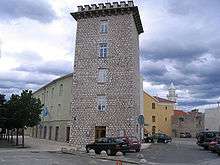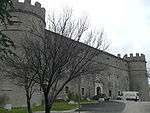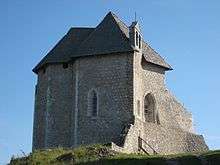House of Frankopan
| House of Frankopan | |
|---|---|
| Country | Croatia, Hungary |
| Titles | Counts of Krk, Modruš and Trsat,[1] Ban of Croatia |
| Founded | 1118 |
| Founder | Dujam I |
| Final ruler | Fran Krsto Frankopan |
| Current head | Extinct |
| Dissolution | 1671 |
The House of Frankopan (Croatian: Frankopani, Frankapani; Italian: Frangipani, Hungarian: Frangepán. Latin: Frangepanus/Francopanus), was a Croatian noble family, whose members were among the great landowner magnates and high officers of the Kingdom of Hungary–Croatia.
History
The Frankopan family was one of the leading Croatian aristocratic families which dates back to the 12th century. Along with the Zrinski family it had, in Croatian and Hungarian history, ranked high in terms of importance by virtue of power, wealth, fame, glory and role in Croatia's public life. Some scholars consider them (according family's tradition) to be closely connected with the Roman patrician Frangipani family.[2] The Frangipani were a Roman princely family, earlier called Onicii or Anicii. The family took the name Frangipani in the 8th century.[3] In 837 four brothers of the Frangipani family left Rome: Michele chose Venice as his domicile and Nicolò Dalmatia and Slavonia. The descendants of Michele obtained the island of Krk from the Venetians.[3] The Croatian family proclaimed themselves "Frankopan" in 1430, and are first mentioned in Croatian documents in 1133 when Dujam of Krk is recorded as ruler and lord of the island of Krk and of areas of Dalmatia. Around 1200 the family owned wide areas on the mainland, including the Castle of Ribnik, near Karlovac.
In 1240–1241 the Mongol Empire advanced from Poland toward Hungary whose King, Béla IV resisted bravely but finally had to seek refuge in Dalmatia. King Béla stayed with the Frankopans who assisted him with arms and funds and brought him into safety in Veglia and then brought him back to his own land. As reward the King gave the Frankopans the county of Senj with surrounding lands and the castle of Modruš.[3]
In 1246 there was another war, between Frederick II, Duke of Austria and Béla, who, with the assistance of the Frankopan, won a victory. As a further reward, King Béla then, by royal decree, created the Frankopans as Lords of their territory for them and their descendants.[3]
The Frankopans constantly supported the Catholic Church. In particular, Nikola Frankopan reconstructed the Holy House of Our Lady in 1294 in Tersatto (Trsat).[3] It is recorded that in 1291, Nikola Frankopan sent a delegation to Nazareth to measure the Holy House after the House had been saved, presumably by the Crusaders, and brought to Trsat or Tersatto, on the Adriatic Coast where the Frankopans had a castle. In 1294 Nikola Frankopan, gave the Holy House to the Pope to be placed on Papal lands, at Loreto, near Ancona.
Although the possessions of the family were exposed to every assault both from the east and the west, their power increased steadily until the 17th century when their lands reached further east. The Zrinski and Frankopan families came into closer affinity by marriage ties until in the eyes of the European courts they had become one of the most important families of Croatia.
In 1420 the Swedish King Erik of Pomerania called Ivan VI Frankopan, the eldest son of the Croatian ban Nikola IV, to Sweden to accompany the Swedish King to the Holy Land and later to assist the King at the Court in Sweden. Ivan VI Frankopan lived in Sweden at intervals between 1420 and 1430. After his father's death he returned to his home country. His eldest son called Matthias (Matija)[4] stayed in Sweden.
In 1425 Emperor Sigismund confirmed the princely title of Nicolaus Frankopan and his relatives and granted the family the privileges of red wax, (Rotwachsprivilegien), i.e., the right to use red wax for their seals, a privilege reserved for sovereign families. Sigismund underlines at the end of this document that no one must ever dispute these rights of the family.[5]
Bernardin Frankopan's (1453-1529) paternal grandmother Dorottya Garai was from a prominent Hungarian noble family, Garay, while his mother Isotta from Este family was Duchy of Ferrara of Ferrara. Through ancestry from royal Spanish families Bernardin had even Árpád ancestry (the Árpád dynasty founded the Kingdom of Hungary.) The Frankopan family was persecuted after the Zrinski-Frankopan conspiracy, where the Count Fran Krsto Frankopan participated in an uprising against Habsburg King Leopold I. He and his brother-in-law, Petar Zrinski were executed in Wiener Neustadt.
The line of Stjepan II Frankopan, Ban of Croatia (d. 1481), died out with Katarina Frankopan in the 16th century. The line of Sigismund Frankopan expired with Franjo Frankopan, Bishop of Eger in 1542. The another branch died out in 1572 with Franjo Frankopan, Ban of Croatia; and the Trsat branch died out with Fran Krsto Frankopan in 1671 (and in the female line with Julianna Frankopan, Countess of Traun).[1]
Notable members

- Ivan V (Anž) of Krk (died 1393). Ban of Croatia
- Nikola Frankopan (Hungarian: Miklós) (c.1360-1432). First "Frankopan", and son of Ivan V of Krk. Ban of Croatia.
- Ivan Frankopan (Hungarian: János) (died 1436). Son of Nikola Frankopan. Ban of Croatia.
- Stjepan Frankopan (Hungarian: István) (c. 1416-1481/4). Son of Ban Nikola Frankopan. Co-Ban with Ivan Frankopan, of Croatia.
- Ivan VII Frankopan - ruled the Principality of Krk 1451–1480.
- Bernardin Frankopan (1453-1529) Son of Stjepan Frankopan. Influential nobleman, diplomat, and warrior.
- Nikola Frankopan (Hungarian: Miklós) (died 1456-1458). Son of Ban Nikola Frankopan. Ban of Croatia and Slavonia.
- Beatrice Frankopan (1480-c.1510). Noblewoman, heiress of Hunyad Castle and wife of John Corvinus.
- Krsto Frankopan (Hungarian: Kristóf) (1482-1527). Son of Bernardin Frankopan. Ban of Croatia.
- Franjo Frankopan (1536 - 1572). Ban of Croatia.
- Vuk Krsto Frankopan (c.1578-c.1652). General of Karlovac generalate.
- Ivan (Franjo) Frankopan - archbishop, bishop, and diplomat.
- Nikola IX Frankopan of Tržac (died 1647). Ban of Croatia.
- Katarina Zrinska (Hungarian: Katalin) (c.1625-1673). Daughter of Vuk Krsto Frankopan. Married Petar Zrinski, Ban of Croatia.
- Fran Krsto Frankopan (Hungarian: Ferenc Kristóf, beheaded in 1671). Promulgated the Zrinski-Frankopan conspiracy, known as Wesselényi conspiracy in Hungary.
Holdings
Several of the Frankopan castles remain in Croatia, mostly around the Gorski kotar region and the island of Krk. The castle at Stara Susica near Trsat incorporates structures going back to the Illyrian and Roman periods. The town of Bosiljevo has a medieval fortified castle, renovated in the last century in the spirit of the Romanesque. The castle and park at Severin na Kupi were owned by the Frankopan family until the mid-17th century. Other castles or property of the Frankopans could be found in Ribnik, Bosiljevo, Novi Vinodolski, Drivenik, Ogulin, Slunj, Ozalj, Cetingrad, Trsat, and other surrounding towns. The Frankopan castle in the town of Krk is currently used for open-air performances in the summer months. Some castles which were propriety of the family:
-
Ruins of Tržan Castle in Modruš, once a seat of the Frankopan family on Croatian mainland
-

Drežnik Castle
-
Grobnik Castle
-

Novi Vinodolski Castle
-
Novigrad na Dobri Castle
-
.png)
Ribnik Castle
-
Slunj Castle
-
Severin na Kupi Castle
-

Stara Sušica Castle
See also
References
- 1 2 Nagy, Iván; Friebeisz, István (1858). "Magyarország családai: Czimerekkel és nemzékrendi táblákkal". Retrieved 2012-12-31.
- ↑ [Gliubich, Simeone, Dizionario biografico degli uomini illustri della Dalmazia, Vienna, 1856, p. 135.]
- 1 2 3 4 5 [Gliubich, Simeone, Dizionario biografico degli uomini illustri della Dalmazia, Vienna, 1856, p. 136.]
- ↑ Petar Strčić (2002). "Vončinin genealoški, onomasiološki i kronološki pristup Franji Krsti Frankopanu". Kolo (in Croatian) (Matica hrvatska) (2). ISSN 1331-0992. Retrieved 2013-02-10.
- ↑ Österreichisches Staatsarchiv, Vienna, Reichsadelsakt Fragiapan, 1425, Dokument 120.6 & 119.16
| ||||||||||||||||||||||||









